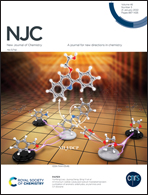Imidazole cores for the construction of dopant-free asymmetric hole-transporting materials for efficient inverted perovskite solar cells†
Abstract
As sandwiched hole transporting material (HTM) layers are in direct contact with up-coated perovskite layers and bottom electrodes in p–i–n structured perovskite solar cells (i-PSCs), the film quality of HTMs determines the morphological properties of the perovskite absorbent. To achieve excellent surface morphology of HTM films, two asymmetric structured HTMs featuring methoxytriphenylamine electron donors and imidazole cores, were successfully developed through two simple reactions of cyclization and Buchwald–Hartwig coupling. DI-TPA was designed by incorporating an extra methoxytriphenylamine unit in the C2 site of the imidazole core, whereas an isolated benzene ring was introduced for DI–Ar. The asymmetrical conformation contributes to high glass transition temperatures and supports thermal-stable amorphous properties in both HTM films. Compared with DI–Ar, DI-TPA featuring with an extended backbone realizes more effective capability of hole extraction arising from the enhanced intermolecular π–π interaction in the solid state. Consequently, the i-PSC with DI-TPA as a dopant-free HTM generates an encouraging power conversion efficiency of 16.54%, significantly exceeding that with DI-Ar (13.77%). It should be noted that the efficiency is shown to outperform that of commercial dopant-free HTM PEDOT:PSS (13.41%) under the same condition. This work offers a fundamental strategy by reinforcing electron donation to improve the hole mobility of asymmetric HTMs for dopant-free p–i–n structured inverted PSCs.



 Please wait while we load your content...
Please wait while we load your content...